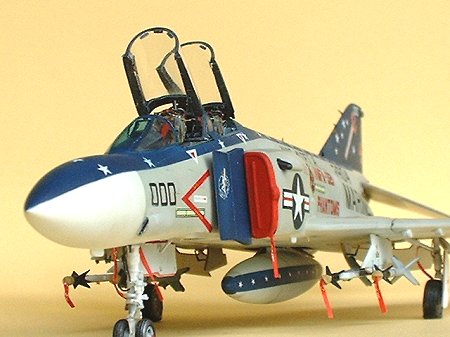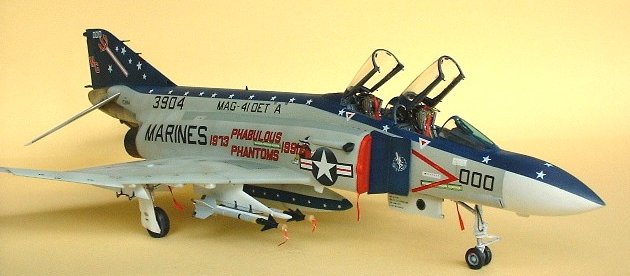
|
KIT: |
Hasegawa 1/48 F-4S Phantom Ii |
|
KIT # |
CH 10 |
|
PRICE: |
$60.00 |
|
DECALS: |
See Review |
|
REVIEWER: |
|
|
NOTES: |
Hi Grade Series Diamond Jubilee kit. |

|
HISTORY |
The main history of this famous aircraft has been covered so well so many times that I could not add very much information that would be of any interest to all. I will tell a little about what and why the “Triple Nuts” (000) Phantom was given one last chance to show off the last of the great days of the colorful Phantoms and all the noise and smoke of the great J-79 engines and why they will last forever in our hearts as one of the greatest airframes ever used. Anything it lacked in performance, was made up with noise.
 Well, the day finally came and
too soon we might add, for the McDonnell Douglas F-4 Phantoms to be sent into
retirement. We all knew that day would come but now it seemed too soon. One of the last squadrons to
operate the Phantoms, was VMFA 321 that was stationed at NAS Andrews, Maryland.
They retired their last Jet during ceremonies at Andrews on the 13th
of July 1991. The only other Marine unit left flying the phantom at that time
was VMFA-112 in NAS Dallas, Texas and they were scheduled to retire their
Phantoms by the end of 1991 also.
Well, the day finally came and
too soon we might add, for the McDonnell Douglas F-4 Phantoms to be sent into
retirement. We all knew that day would come but now it seemed too soon. One of the last squadrons to
operate the Phantoms, was VMFA 321 that was stationed at NAS Andrews, Maryland.
They retired their last Jet during ceremonies at Andrews on the 13th
of July 1991. The only other Marine unit left flying the phantom at that time
was VMFA-112 in NAS Dallas, Texas and they were scheduled to retire their
Phantoms by the end of 1991 also.
The VMFA-321 Phantom , F-4S BuNo. 153904 know to all as, “Triple Nuts” (000), final days ended in true Marine Corp style. Triple Nuts was stripped and painted during June and July 1991 and received a new glossy paint job of Lt. Gull gray and White, reminiscent of the good old days when the fleet was full of brightly colored airplanes. This new scheme would be a contender for the most colorful art job of any Phantom even all the way back to 1976.
When the over all Paint job was complete, Don Spering of A.I.R. applied the final Art work. Triple Nuts was flown for two (2) photo missions and then retired and has become a static display at the squadron facility. VMFA-321 converted to the F/A-18A in early 1991.
|
THE KIT |
 As we all know by
now, Hasegawa has the very best model kits of the McDonnell Douglas F-4 Phantoms in
several different kit forms. However, they never produced the “S” version in a
high quantity unless for special version like the so called, “Hi Grade” series.
That is the kit I started with. The kit was given to me by a friend of mine
several years ago when he was getting out of the building hobby and wanted me to
build it someday. It set on the shelve for a long time but after Repli-scale
came out with the Triple Nuts decal sheet I knew my next Phantom build would be
that version . The Hasegawa Hi-Grade series F-4S Phantom is just like the “J”
except there is all the parts and changes to make it into the “S” type and had
lots of etched metal and metal landing gear and vinyl tires and a very nice
large decal sheet for 2 or three aircraft mainly for the Golden Jubilee version
with the dark blue paint scheme. Other than that, it was the nice usual
Hasegawa Phantom kit with all the nice recessed lines, and a decent interior of
which I did not use because of the a bad case of AMS on my part.
As we all know by
now, Hasegawa has the very best model kits of the McDonnell Douglas F-4 Phantoms in
several different kit forms. However, they never produced the “S” version in a
high quantity unless for special version like the so called, “Hi Grade” series.
That is the kit I started with. The kit was given to me by a friend of mine
several years ago when he was getting out of the building hobby and wanted me to
build it someday. It set on the shelve for a long time but after Repli-scale
came out with the Triple Nuts decal sheet I knew my next Phantom build would be
that version . The Hasegawa Hi-Grade series F-4S Phantom is just like the “J”
except there is all the parts and changes to make it into the “S” type and had
lots of etched metal and metal landing gear and vinyl tires and a very nice
large decal sheet for 2 or three aircraft mainly for the Golden Jubilee version
with the dark blue paint scheme. Other than that, it was the nice usual
Hasegawa Phantom kit with all the nice recessed lines, and a decent interior of
which I did not use because of the a bad case of AMS on my part.
|
CONSTRUCTION |
This was a
big box of plastic and etched metal and to top all that off, was a KMC detail
set I got somewhere. Since the kit did not cost me anything, I decided to spend
some bucks for what I thought was more detail. In truth, it would not have be
all that necessary as what was in the kit would be fine most of the time. But I
went to the trouble anyway and after about 100 fittings
 with the resin cock pit
and sidewalls to get it to fit, ( so much for, “it is an exact fit syndrome”)
the cockpit was ready to paint all the basic colors of dark gull gray with black
instruments, and side consoles and seats. The seats were finished and set aside
and then the fit of the wings to fuselage began. No filler was needed at the
wing roots but as always, some filler was needed all the way up and down the
spine and the bottom. All the hanging parts were left off until a later part of
the construction phase.
with the resin cock pit
and sidewalls to get it to fit, ( so much for, “it is an exact fit syndrome”)
the cockpit was ready to paint all the basic colors of dark gull gray with black
instruments, and side consoles and seats. The seats were finished and set aside
and then the fit of the wings to fuselage began. No filler was needed at the
wing roots but as always, some filler was needed all the way up and down the
spine and the bottom. All the hanging parts were left off until a later part of
the construction phase.
While it did have a nice set of metal gear, the tires were rubber, which I did not like so, I went next to the tire store, and got some True Detail wheel replacements. They only installed the centerline tank on the “Triple Nuts” aircraft so the extra tanks went in the spares box. It was welded together and seams filled and set aside. I tried to install all the 1000 parts carefully as I could so that when the paint scheme was ready it would be as flaw free as I could get it. During all the major construction, I would set it aside sometimes and work on some of the other semi-finished pile I have like everyone else.
The kit came with no weapons as usual, and all the pictures I had of the “OOO” aircraft did not show any, but did have the ‘winder rails, I decided that some sidewinders would not be too much out of line and it would give me something to hang that would not look out of place.
After a good long while of sanding, priming, all the seams, filling pin marks, check all the details, I was now ready for some serious masking and running down all the colors and a game plan to go to the Paint table where the EPA dares not to come to my house with any environmentalists want-a-be.
|
PAINT & DECALS |
 The paint
scheme was going to be easy on this one. Light Gull gray and white and the
blue would have to be compared to what the model paint racks had to offer, the
one best suited was the Humbrol # 25 blue. The other paints were Model Masters.
The gray and white was sprayed first and then I masked the blue area with stripeing tape so that I could get a nice hard line. After gloss coating with
floquil gloss coat, about three times, I was now ready for the Repli-scale
decals.
The paint
scheme was going to be easy on this one. Light Gull gray and white and the
blue would have to be compared to what the model paint racks had to offer, the
one best suited was the Humbrol # 25 blue. The other paints were Model Masters.
The gray and white was sprayed first and then I masked the blue area with stripeing tape so that I could get a nice hard line. After gloss coating with
floquil gloss coat, about three times, I was now ready for the Repli-scale
decals.
The decals were very nice, but a little large but I could not stretch the model so I put them on anyway. All the stars were all individual units so I had to look at the pictures closely. After two coats of testors dull coat, it was now ready for me to finish the cockpit with all the nice etched metal and install the seats. There was lots of detail that went into the canopies as well. After all the gear and tank and ‘winders were installed, I painted edges of all the gear doors with a small fine point red pen. The finished product was now ready for the setting hanger.
|
CONCLUSIONS |
What can I say, the Hasegawa Phantoms in 1/48 scale are the very best you can get, period. They are a joy to build and we will try to continue to build one once in a while. The detail I put in this is slightly overdone but that is what I wanted to do and it is a conversation piece and does have a gaudy paint job that is a nice piece of history.
December 2002

|
REFERENCES |
If you would like your product reviewed fairly and quickly by a
site that has well over 150,000 visitors a month, please contact
me or see other details in the Note to
Contributors.